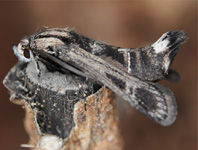Abstract
Six new species of Fergusobia, from large multilocular shoot bud galls on two species of Angophora and four species of Eucalyptus from both subgenera Eucalyptus and Symphyomyrtus, are described. Fergusobia cosmophyllae Davies n. sp. is characterized by the combination of a C-shaped parthenogenetic female with a short arcuate conoid tail, a broad (small a ratio) arcuate infective female with an hemispherical tail tip, and an arcuate to J-shaped male with broad, angular spicules and short bursa. Fergusobia delegatensae Davies n. sp. has an open C-shaped parthenogenetic female with a broadly conoid tail, an infective female of variable shape with an hemispherical tail tip, and a male of open C-shape with a crenate bursa that arises 40–70% along the length of the body from the tail tip and terminates just anterior to the cloaca. Fergusobia diversifoliae Davies n. sp. has a C-shaped parthenogenetic female with a conoid tail, an arcuate infective female with a hemispherical tail tip, and an arcuate, C- or J-shaped male with angular spicule and a long peloderan bursa. Fergusobia floribundae Davies n. sp. has a C-shaped parthenogenetic female with a narrow, arcuate, conoid tail, an arcuate infective female with a hemispherical tail tip, and an arcuate or J-shaped male with an angular spicule and a short to mid-body length peloderan bursa. Fergusobia minimus Lisnawita n. sp. has a C-shaped parthenogenetic female with a conoid tail, an arcuate to open C-shaped infective female with a hemispherical tail tip, and an arcuate to open C-shaped male with an angular spicule and a peloderan bursa arising at about 10–30% of body length. Fergusobia pimpamensis Davies n. sp. has an open C to C-shaped parthenogenetic female with a narrow conoid tail, an arcuate to open C-shaped infective female with a hemispherical tail tip, and an arcuate to C-shaped male with an arcuate spicule and a long, crenate, peloderan bursa. An inventory of all known Fergusobia/Fergusonina associations from terminal shoot bud galls is presented. The larval shield morphology of the associated mutualistic Fergusonina species is discussed where known. Analyses of DNA sequences of D2/D3 and COI suggested that the six new species are distributed between three clades of Fergusobia.

